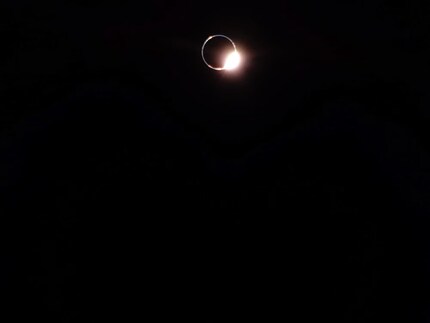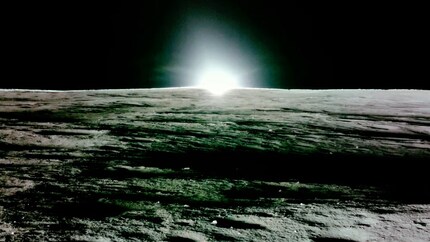
Lunar probe Blue Ghost 1 falls silent - probably forever
The mission of the lunar probe Blue Ghost 1 has come to an end after the sun set in Mare Crisium. Shortly before the end of its mission, the probe made some fascinating observations: It recorded a total solar eclipse and was able to document the sunset on the lunar horizon.
After 14 busy days, the mission of the Blue Ghost 1 lunar probe, which landed in Mare Crisium on 2 March 2025, came to an end as planned when the sun set at the landing site. The last radio signals were picked up in the early morning of 17 March at 0:15 CET, around five hours after the local sunset. The probe, built by the Texan private company Firefly Aerospace, was purely solar-powered and also used rechargeable storage batteries.
Just before the end, Blue Ghost 1 made some fascinating observations: On 14 March, for example, it was possible to follow a solar eclipse from the moon again after around 58 years; the last time this had been achieved with the Surveyor 3 probe was on 24 April 1967, albeit with a very simple black-and-white television camera by today's standards. In contrast, Blue Ghost used several high-resolution digital colour cameras to document the spectacle. Two days later, the probe followed the sunset in Mare Crisium, only to fall silent forever.

Source: © Firefly Aerospace (Ausschnitt)
From Earth, a total lunar eclipse was visible in the western hemisphere - here, the moon had already set before reaching the total phase. The images from Blue Ghost 1 show the probe and the surrounding landscape in a deep red light. In the firmament, the Earth was emblazoned with an attractive bright ring. Unlike total solar eclipses on Earth, this is not the light from the corona - the sun's outer atmosphere - but the light refracted in the atmosphere and deflected towards the moon. The Earth is illuminated from the moon with four times the visible diameter of the sun. During the approximately two-hour total phase, the temperature of the probe dropped by more than 100 degrees Celsius, as there is no atmosphere on the moon to protect it from cooling.
"The sun has set, the bright Earth and Venus are resplendent"
The images that the space probe captured of the lunar sunset with its high-resolution cameras are also impressive. It captured the "lunar glow" described by Apollo 17 astronaut Eugene Cernan in December 1972. At the time, the sensitivity of the analogue film cameras was not sufficient to capture the phenomenon, which is why Cernan documented his observations with drawings in the mission book. Now the images from Blue Ghost 1 show the phenomenon quite clearly: the sun has just disappeared behind the horizon, with a narrow strip of light spreading along the horizon to its left and right. A cone-shaped brightening can be seen above the location of the sun. These effects are probably due in part to stray light in the camera, the solar corona and fine dust floating above the surface of the moon.

Source: © Firefly Aerospace (Ausschnitt)
The bombardment of the airless lunar surface by solar particle radiation gives it a negative electrical charge. The fine dust also acquires a charge and is repelled from the similarly charged surface - so strongly that it floats above the surface in the low lunar gravity (one sixth of the Earth's gravity). During the 14-day lunar night, the surface and the dust particles discharge again, causing the dust to sink back. This effect must also be taken into account in future lunar missions, as it contributes to sensitive surfaces such as lenses or telescope mirrors becoming coated with dust.
During the 14 days on the moon, Blue Ghost 1 was also very active from a scientific point of view: ten experiments served various research and technological purposes. For example, a drill powered by nitrogen gas penetrated around one metre into the ground beneath the probe. In addition, magnetotelluric measurements were carried out with four sensors connected to 20 metre long cables together with a magnetometer. These investigations serve to find out more about the interior of the moon and the electrical properties of the lunar soil. Using a special antenna, it was also possible to pick up the radio signals of terrestrial navigation satellites on the moon - this could be useful in future for astronauts who need to orientate themselves precisely on the moon. However, a separate network of lunar navigation satellites is planned for the future.
With the soft landing of Blue Ghost 1, Firefly Aerospace has become the first private company to carry out a truly successful mission without any limitations. Other competitors have not been able to do so until now, as the failed landing of the IM-2 Athena probe from Intuitive Machines on 6 March made clear once again. In any case, the US space agency NASA, on whose behalf Blue Ghost 1 was travelling, was very satisfied. Next year, Firefly Aerospace will carry out two more landings on the moon with the tried-and-tested system.
Spectrum of Science
We are a partner of Spektrum der Wissenschaft and want to make well-founded information more accessible to you. Follow Spektrum der Wissenschaft if you like the articles
Originalartikel auf Spektrum.de
Experts from science and research report on the latest findings in their fields – competent, authentic and comprehensible.
From the latest iPhone to the return of 80s fashion. The editorial team will help you make sense of it all.
Show all